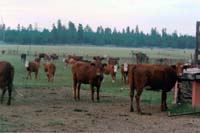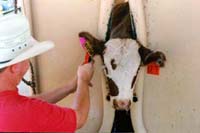| V Bar V Cattle Vaccinations Research in progress tests different strategies
Respiratory illnesses in cattle tend to go beyond a common cold. They may escalate rapidly into bovine respiratory disease complex (BRDC), a combination of viral and bacterial infections that develops into pneumonia. Treatment involves both pharmaceutical costs and the labor to search out and bring in the sick animals. Cattle on the range usually don't have a problem with BRDC but when calves are weaned, moved through a sale barn, transported long distances and then placed in a feedlot or on pasture the stress they experience will cause BRDC to develop. "The ranchers don't have a real intensive program for vaccinating their calves," says Peder Cuneo, a veterinarian in the UA College of Agriculture. This is because most cattle are pastured in very large range conditions and are rounded up only a few times each year. "As a result, weaned calves, when marketed, may have health problems. When the cattle are stressed, viruses get the ball rolling and then bacteria get into their lungs." At that point, some cattle become chronically ill and don't gain well, while others die. "We are concerned Arizona cattle producers maybe getting discounted for their cattle because they're not usually vaccinated before weaning and shipping," Cuneo continues. "We wanted to look at several different vaccination problems as part of a pilot program to set up a larger study." The research began in May 1998 at the V Bar V Ranch, a College of Agriculture experiment station in north central Arizona. Using the ranch herd, Cuneo and his team randomly selected 100 steers as they came through the chute, and divided them into four treatment groups of 25 each. The V Bar V calf crop comprises purebred Herefords, Hereford crosses with Barzona and Salar and composites from another ranch, the Bar T Bar. All of the bulls used at the V-V are purebred Herefords.
The control group received no vaccinations; a second group was vaccinated with a single dose of a killed product in May; the third group had two doses of a killed product in May and September, and the fourth received a killed dose in May, followed by a modified live vaccine on the ranch in September. To mimic actual commercial conditions as closely as possible, the calves were sent after weaning the following week to a sale barn in Marana. From there they were transported to the West Campus Agricultural Center feedlot in Tucson and vaccinated on arrival with a modified live product. "The calves were all co-mingled," Cuneo says. "We had two students doing the pen- riding, to pull out sick calves. We kept those in hospital pens and took extensive notes for each calf on the length of illness, its weight in and out of the pen, and its response to treatment." Preliminary results have shown that during the stress of weaning and shipping, a modified live virus might not be advisable, according to Cuneo. However more work still needs to be done with a larger group of calves. "We want to come up with a background strategy for a quality assurance program, to develop an effective vaccination program that works for Arizona producers," Cuneo says. To that end, he is also conducting two other pilot projects with the same group of calves. One of them is focusing on vitamin E and selenium levels in the blood of 25 calves, plus the varying content of E. coli bacteria in their feces. Although E. coli is a normal part of the bovine digestive flora, the amount and the strains present can change during the animal's feeding cycle. Cuneo is looking for the strains that are potentially pathogenic to humans. "We want to know when and where these strains show up. Is it from
other animals, the feed? We don't know yet," Cuneo admits. The other
study underway compares three different body placements for clostridial
vaccines. Aimed at preventing deadly diseases caused by Using the same 100 cattle divided into groups of about 33 each, Cuneo
and his associates have injected the clostridial vaccine in front
of the shoulder in one group, at the base of the ear in the next group
(as recommended by researchers at Texas A&M), and at the base
of the tail in Cuneo notes that a tremendous number of people are involved in this work. The three studies are a collaborative effort among several College of Agriculture departments, and include students and staff members from the V Bar V Ranch, the Department of Animal Sciences, the West Campus Agricultural Center feedlot, the UA Meat Lab, the Department of Veterinary Science and Microbiology, and the Veterinary Diagnostic Laboratory. Facilities Improvements on the V Bar V Ranch The V Bar V Ranch, a College of Agriculture experiment station located in north-central Arizona, has recently upgraded its facilities to better accommodate research and educational activities. Research involves an applied approach to problem solving as well as studies in basic science. Animals from the ranch provide researchers on campus with the opportunity to do studies such as trace mineral analyses and the use of DNA technologies as a means of identifying parentage. The winter headquarters are located on land administered by the USFS near Camp Verde. A 40' x 100' metal building has been erected. This building provides a shop for maintaining equipment, living quarters for student interns and covered storage for hay. Other facilities include a mobile home, where the ranch manager is housed, and corrals. All of the fencing has been rebuilt, including ten miles of completely new fence. With assistance from the USFS 25 cattle guards have been installed at strategic locations. The water storage capacity is currently being upgraded at the winter headquarters to increase the ability to hold cattle at this location for working. Water lines in some of the pastures are also being upgraded. The summer headquarters at Mahan Park consists of 43.75 acres with three existing buildings and corrals. In addition, a $30,000 grant was received from the Arizona Advisory Council on Environmental Education. This is funded from environmental license plant money administered by the State Land Department. The grant will be used to build a covered ramada and upgraded toilet facilities at Mahan Park. Deb Young and Cooperative Extension sources Article written by Susan McGinley, ECAT, College
of Agriculture Researcher:
|


 clostridial bacteria (see article in this issue), the commonly used
vaccine usually includes seven or eight vaccines in one shot. Because
severe injection site lesions may develop when the vaccine is introduced
into muscle, it is now mostly given under the skin.
clostridial bacteria (see article in this issue), the commonly used
vaccine usually includes seven or eight vaccines in one shot. Because
severe injection site lesions may develop when the vaccine is introduced
into muscle, it is now mostly given under the skin.  the third. After slaughter, he will examine the muscle tissue for
the effects of the vaccine. For all of these studies, the calves receive
different ear tags to designate which studies they are in and the
treatments applied. Thus far, Cuneo says the tail area vaccines look
promising.
the third. After slaughter, he will examine the muscle tissue for
the effects of the vaccine. For all of these studies, the calves receive
different ear tags to designate which studies they are in and the
treatments applied. Thus far, Cuneo says the tail area vaccines look
promising.